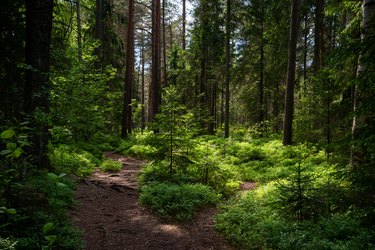
What are the four stages of ecological succession? Like human beings, biological communities are living things that go through different stages that you can break down into different categories. These communities can contain plant life, animals, rocks, dirt, insects and humans. Plant succession is something that many students who are learning about botany and science often learn.
The Different Stages of Ecological Succession
Video of the Day
Interestingly, some experts say that there are five stages of ecological succession, while others show that there are four successional stages of forests. The five are thought to be nudation, invasion, competition/coaction, reaction and stabilization, or climax. Some experts combine competition/coaction and reaction into one stage, which brings the total number down to four. Nevertheless, each stage has specific qualities that separate it from the others.
Video of the Day
Nudation is the starting point or a bare area formed by a landslide, eruption or flooding; invasion is when organisms settle in. Competition/coaction is when you see an increase in the number of species within the limited space. Reaction describes how the new environment is modified by the organisms, causing changes to the soil, water, temperature and land. The final phase of stabilization or climax is when the environment has settled down, and you have a system like a forest, coral reef or beach that has reached a sort of equilibrium.
Plant Succession Example
Plant succession is an example of ecological succession and can be small, medium or large in scale. Countless factors determine whether or not a plant or an entire environment will thrive. Consider a plant succession example that shows how an individual plant could succeed. Sand dunes could accumulate along the edge of a lake, and the first invaders could be mosses and lichens. As these grow and decay, they produce humus that supports the growth of different grasses.
This grass could then lead to the growth of low bushes, like blueberries, which pave the way for popular trees and then white pines. These larger trees provide a lot of shade, which may cause the effect of wiping out the lower trees and bushes that need full sun. If a hurricane were to occur after things stabilized, it could wipe out everything, and things would return to the initial nudation stage.
Is a Lake the Oldest Stage of Succession?
Lakes are not necessarily the oldest stage of succession; lakes are formed by receding glaciers that leave large depressions known as kettle lakes. Crater lakes form from depressions left by asteroids and volcanic eruptions. The stage of succession a lake is in depends on how much water, sediments and nutrients are going in and out. For example, lakes with many sphagnum mosses can get taken over as the moss absorbs more and more of the water. These can eventually turn into giant peat bogs like the ones seen in Alaska's Denali National Park.
Lakes can also go through eutrophication, which can take over the environment. Nutrients, like fertilizers and animal waste, and inorganic materials, like phosphates, can get into the lake and the surrounding area, causing plants, like algae, to form. This algae makes the water greener and cloudier, and once the algae dies, they sink and decompose. This decomposition decreases the amount of available oxygen, which can cause the living things in the lake to die.
Lakes and other ecosystems rest on delicate balances, so too much of anything, especially pollution, can take everything back to another stage. A falling asteroid, chemical runoff, too much moisture or not enough sun might eradicate all of the life in an environment. It can be one single instance or something that accumulates over time. Sometimes, an ecosystem is permanently changed for better or worse, and other times, it disappears forever.